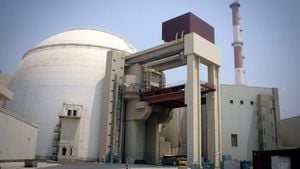Residents of Lahore and Delhi are once again grappling with hazardous air quality, as thick, toxic smog casts a pall over these two densely populated Indian subcontinent cities. The current smog crisis has drawn attention not only from local residents but also from international observers, with satellite imagery of the smog blanket drawing alarm worldwide.
Nasa’s recent satellite images vividly captured the smog blanketing Lahore and other parts of northern India, illustrating the extent of this environmental crisis. The sight showed vast areas of gray haze, starkly visible against the once vibrant landscapes. The vice grip of smog has choked these urban centers, exacerbated by the seasonal burning of crop stubble, industrial emissions, and heavy vehicular traffic, are major contributors to the summer’s air pollution levels, which have spiraled out of control.
Lahore, Pakistan, is currently facing the brunt of this pollution crisis. Reports indicate Lahore's Air Quality Index (AQI) has soared to hazardous levels, at times exceeding 1,000. Comparatively, New Delhi, which typically ranks among the most polluted cities globally, is struggling with AQI readings as high as 400. While the acceptable AQI level is below 50 for good air quality, both cities stand far above this safe threshold, indicating severe health risks, especially for vulnerable populations such as children and the elderly.
The smog is composed of particulate matter, which includes harmful chemicals, dust, and toxins. These tiny particles can infiltrate the lungs, leading to various health issues like respiratory ailments, asthma, and even cardiovascular diseases. Medical professionals have sounded the alarm over the health impacts, with hospitals reporting increased visits related to respiratory distress and other pollution-related illnesses. Official figures reveal over 30,000 individuals have sought treatment for breathing problems triggered by the foul air this season.
Due to the alarming rise of air pollution, the Lahore government has taken drastic steps. Schools and parks have been shuttered, and residents are discouraged from outdoor activities. Authorities have limited business hours for outdoor establishments, typically mandatorily closing at dusk to mitigate health risks associated with exposure to poor air quality after sunset.
Experts have noted the smog problem tends to worsen during winter months when weather conditions trap pollutants near the ground. Factors like the decrease of wind speeds and the onset of cooler temperatures contribute to this stagnation effect, effectively sealing pollutants within the cities. This seasonal variation means residents often see the worst air quality as the year ends.
Urban policymakers have attempted to trace various sources of pollution, identifying crop residue burning as one of the primary contributors to Lahore's plight. Smog resulting from burning practices, especially prevalent among farmers striving to clear fields post-harvest, has caused about 30% of Lahore's pollution crisis. Farmers have been urged to seek alternative methods for clearing fields, yet resistance persists, and regulations prohibiting stubble burning remain largely unenforced.
Efforts have been made by authorities, including the establishment of Punjab's 'smog war room,' dedicated to tackling the looming crisis through joint initiatives across various departments. The war room aims to identify pollution sources, manage traffic emissions, and provide real-time monitoring of air quality, though immediate results are slow to manifest amid the scale of pollution.
More pressingly, the Lahore government has sought collaboration from Indian officials to address transboundary pollution interactions between the two nations. Punjab’s Chief Minister Maryam Nawaz highlighted the ecological interconnectedness of pollution, noting, "The winds don’t know there’s a border between India and Pakistan." This appeal indicates not simply the recognition of pollution's human-induced origins but also hints at possible diplomatic outreach related to shared environmental concerns.
Meanwhile, New Delhi faces its own set of challenges amid deteriorated air quality as it too wrestles with its infamous pollution levels. While temporary measures have been enacted there to alleviate the pollution crisis, including closing schools and restricting outdoor activities, the residents appear to struggle without substantial long-term changes to underlying industrial practices and emissions standards.
Delhi's air quality has frequently registered as 'very poor,' remaining precarious for residents. Local health officials express concern for the general population, particularly vulnerable groups facing heightened risks from air pollutants. Such widespread pollution poses alarming prospects for public health, just as it does across the border in Lahore, painting both cities as rivals not only on the political stage but also as neighbors sharing the burden of existential health risks brought on by environmental negligence.
Returning to public health impacts, health officials have repeatedly linked high levels of particulate matter to mounting cases of chronic illnesses. The World Health Organization cautions against prolonged exposure to high pollution levels, which can result not only become part of everyday health hazards but also lead to serious conditions like stroke, heart disease, and lung cancer.
UNICEF also flagged the situation's severity, reporting significant health risks for over 11 million children under five years residing within Punjab, contributed largely by deteriorated air quality. Abdullah Fadil, UNICEF’s representative to Pakistan, expressed alarm over the environmental health risks for children, stating, “Children have no choice but to breathe this polluted air.” Such statements reinforce the compelling need for urgent action from governments, health authorities, and civil society to combat pollution at its roots.
Climate scientists and activists alike assert the necessity of more rigorous policies aimed at curbing emissions from multiple sources, including vehicle exhaust, power generation, and industrial waste. Moving forward, achieving sustainable practices could be instrumental for harmful changes contributing to air quality. Several advocacy groups have actively engaged with regional policymakers, calling for comprehensive plans centered on sustainable energy transitions and improved public transport options.
Simultaneously, residents of both cities express frustration and health alarms, primarily growing tired of annual cycles where air quality crises recur due to severe weather patterns, agricultural practices, and lack of solid regulations against polluting sources. With each passing year, the smog threatens to split communities even as it metaphorically shrouds their connection.
The unsettling reality is evident as we witness deeply connected narratives of air quality between these two cities, yet action-oriented responses and collaborative efforts seem riddled with procrastination and geopolitical friction. Increasingly at risk, the populations of Lahore and Delhi must remain vigilant as they press for necessary reforms and health protections, pushing for sound policies to alleviate the grips of toxic air pollution and the dangers it presents.
One has to wonder: as the smog settles heavier this winter, will there be adequate responses to tackle pollution's dire reality? Political will and cooperation might be the key, yet as history shows, geographic borders can sometimes equate to barriers against the drive for joint environmental stewardship.



